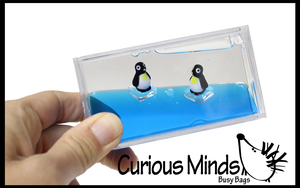Kanoodle® Jr. - Logical Thinking Puzzle Game
Curious Minds Busy Bags
Puzzle play isn't just for the big kids anymore! Based on the award-winning Kanoodle(R) brain game series, Kanoodle Jr. offers on-the-go spatial-reasoning fun with simple-to-follow instructions and large puzzle pieces, perfect for little hands. Kanoodle Jr. includes 60 head-scratching puzzle challenges that easily slide into the Kanoodle Jr. board for solo play-perfect for kids 4-7.
- Includes 6 large puzzle pieces, perfect for small hands
- Puzzle book with 60 kid-friendly puzzles
- Puzzle board doubles as a carrying case (with handle)
- Helps develop spatial-reasoning and critical-thinking
Kanoodle Jr. is a collection of fun, logical thinking puzzles for kids. It’s great for developing spatial reasoning and critical thinking skills. Kids will have hours of enjoyment working on these 60 puzzles. The portable case makes it easy to take Kanoodle Jr. anywhere!
The puzzles are leveled with stars .
Start younger kids on one-star puzzles to introduce them to Kanoodle Jr. Encourage them as they work on the solution. Puzzles with more stars are harder and will take more time to figure out. With a little determination and maybe some luck, they’ll surprise themselves, and even you!
Kanoodle Jr. comes with three types of puzzles:
1. Color-match puzzles
2. Path puzzles
3. Wall puzzles
To start, select any puzzle from the puzzle book and slide the booklet into the case. The puzzle should show through the square openings in the puzzle board. Solve the puzzle by placing the puzzle pieces on the board. Note: The solution requires that the puzzle pieces lay flat on the puzzle tray (all blocks of each puzzle piece used must touch the puzzle tray).
Instructions for Color-Match Puzzles
Puzzle pieces used: All 6 pieces.
The goal of these challenges is to use all 6 puzzle pieces to solve the color-match puzzle.
• Cover the colored icons with puzzle pieces that match the color. (For example, the red “Rocket” must be covered by the red puzzle piece .)
• A puzzle piece may not cover an icon that is a different color
than the puzzle piece. (For example, the red puzzle piece can not cover the blue “Rocket” .)
• Spaces that don’t have icons can be covered with any colored puzzle piece. • Easier puzzles show you more colored icons. Harder puzzles show you fewer colored icons.
Note: The puzzle pieces can not touch any part of the path marked with gray icons (for example, dinosaur footprints ).
• You’ve solved the puzzle correctly when the only spaces left create a path between the two objects that are circled.
Instructions for Wall Puzzles
Puzzle pieces used: 2, 3, 4, or 5. The player needs to figure out which ones are needed!
The goal of these puzzles is to create a wall between the two types of objects. For example, you want to separate the dogs and the cats with a wall.
• Use the puzzle pieces to create the wall.
• Puzzle pieces can not cover any of the object icons.
• All empty spaces (ones without icons) must be covered.
• When the puzzle is finished, only two types of objects (for example, bears
and honey ) should be showing.
Psst...They're Learning!
- Spatial-reasoning
- Problem solving
- Critical-thinking


















